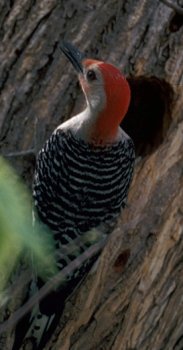Red-bellied Woodpecker (Melanerpes carolinus)

TPWD ©
- Description
- Male red-bellied woodpeckers are medium sized birds that have red caps and hind necks, black and white barred backs and tails. Their belly feathers are off white with a reddish tinge. Females are similar to males but lack the red hind neck.
- Life History
- Red-bellied and other woodpeckers are important nest providers for many other species. The holes they excavate in dead trees, poles, and fence posts are used by bluebirds, wrens, chickadees, and titmice to name just a few. It is important for many bird and animal species that we leave dead trees whenever it's safe to do so! Humans feel that dead trees are dangerous and remove them. This reduces the number of places that woodpeckers, and all the other wildlife that count on them for homes, can live.
Woodpeckers sometimes use telephone poles in the place of dead trees. Occasionally they will try to excavate a nest through the wooden siding of someone's home, or use the metal siding to increase the noise of their tapping to attract a mate. Courtship between red-bellies includes mutual tapping and v-shaped flights. Most red-bellies remain year round. In urban areas their nests are often taken over by starlings after they have finished building them. They excavate a new nest hole each time they renest during the season.
It takes only 7 to 10 days for a pair of red-bellied woodpeckers to carve a home in a dead tree. Red-bellied woodpeckers will occasionally use bird houses. These woodpeckers have been known to store food in hollow trees. Their diet consists of insects, nuts, fruits, and berries. You can attract red-bellied woodpeckers to bird feeders by providing them with peanuts.
The woodpecker's bill is a multi-use tool for food gathering and even more unusual, to get their courtship message out. Male woodpeckers do not sing well, so they use their heads, literally. In the spring, woodpeckers are especially attracted to any sound that resonates, including aluminum shed roofs and even the hoods of cars, much to the annoyance of their human owners. - Habitat
- They prefer forests, swamps or wooded suburban habitats.
- Distribution
- Red-bellied woodpeckers are found in eastern Texas and U.S.